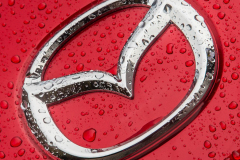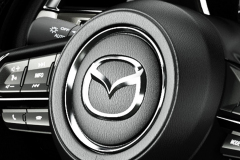Mazda
Mazda began as the Toyo Cork Kogyo Co. Ltd., a manufacturer of machine tools, founded in Hiroshima, Japan, in 1920. The first Mazda car appeared in 1931, the Mazda-Go three-wheeled truck (an auto rickshaw). This was the only car that was in production until the Second World War broke out when Mazda factories began making rifles.
After the War, production and export resumed in 1949 with the same 3-wheeled truck. The first 4-wheel truck was the Mazda Romper, introduced in 1958.
The Mazda R360 coupe was introduced in 1960, followed by the Mazda Carol in 1962.
Beginning in the 1960s, Mazda decided to put a major engineering effort into development of the Wankel rotary engine as a way of differentiating itself from other Japanese auto companies. Mazda formed a business relationship with German company NSU and began with the limited-production 1967 Cosmo Sport grand touring coupé. Mazda chose to use the name “cosmo”, reflecting international cultural fascination with the Space Race. Mazda wanted to showcase the rotary engine as forward-thinking, with a focus on future developments and technology.
Mazda is now the sole manufacturer of Wankel-type engines for the automotive market. NSU and Citroën both gave up on the design during the 1970s, and prototype Corvette efforts by General Motors never made it to production.
The Mazda R100 (1200/Familia) 2 door/2+2 coupé, RX2 (616/Capella) family car, Mazda RX3 (808/Savanna) sports car, Mazda RX4 (929/Luce) executive car and Mazda RX5 (121/Cosmo) grand tourer were some of the first Mazda cars imported into the US in the 1970s.
With the 1973 oil crisis, demand for the thirsty rotary engines dropped, but Mazda hadn’t given up on piston engines and was able to use a 4 cylinder model in the smaller Familia and Capella series.
Mazda wasn’t about to give up on its sporty cars either and decided to develop a parallel plant that would produce cars outside the mainstream. In 1978, they came up with the very sporty Mazda RX7 and later with the Mazda RX8. The piston engine also showed up on the highly successful Mazda MX-5 Miata.
The Familia AP GLC (Great Little Car) debuted in January 1977 as a rear-wheel-drive subcompact. Newer models were banded Mazda 323 and Mazda Protégé.
The 1980 BD Familia, was Mazda’s first front-engine, front-wheel drive subcompact car, and was available as a hatchback and sedan. It was developed with input from Ford, which in 1979 had acquired a stake in Mazda. Many Mazda vehicles at this time were rebadged and sold as Fords.
Familia series production ended in 2003 and the line was replaced by the Mazda 3 hatchback in early 2004.
North America is Mazda’s biggest market.
SkyActiv technology is an umbrella name for a range of technologies used in certain new Mazda vehicles. These vehicles include the Mazda2 (121/Demio) supermini, Mazda6 (Atenza) mid-size car, Mazda 3 (Alexa) compact hatchback, Mazda 5 (Premacy) compact minivan, MX-6 front-engine/front-wheel-drive coupé, MX-5 roadster and the CX series of subcompact SUVs.
In the racing world, Mazda has had substantial success with both its signature Wankel-engine cars, as well as its piston-engine models. Mazda vehicles and engines compete in a wide variety of disciplines and series around the world.
More Mazdas are raced every week than any other car brand, mainly because of the success of the MX-5 Miata and its widespread embrace by grassroots motorsports.
In 1991, Mazda became the first Japanese automaker to win the 24 Hours of Le Mans overall, with the Mazda 787B powered by a four-rotor wankel-type engine. This triumph remains unparalleled, as it remains the only non-piston-engined car ever to win at Le Mans, and Mazda is the first Japanese marque to have won overall at Le Mans. This led to a ban on rotary engines in the Le Mans race starting in 1992, which has since been rescinded.
Mazda also maintains sponsorship of the Laguna Seca racing course in California, using the track for its own automotive testing purposes as well as for numerous racing events. Laguna Seca was used for the 2003 launch of the Mazda RX-8.
Since 2000, Mazda has used the phrase “Zoom-Zoom” to describe what it calls the “emotion of motion” that it claims is inherent in its cars.
The Mazda name was associated with Ahura Mazda (God of Light), with the hope that it would brighten the image of their compact vehicles.
For the future, Mazda intends to maintain its forward thinking and experimental technology, by developing a hydrogen-powered car.


